Exploring Brain Stem Masses: Diagnosis and Treatment
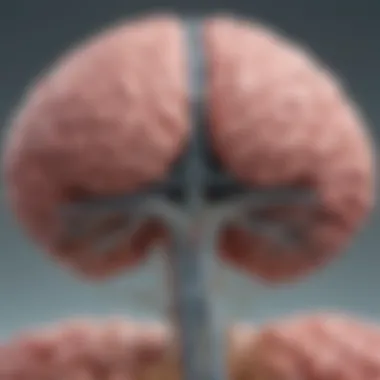
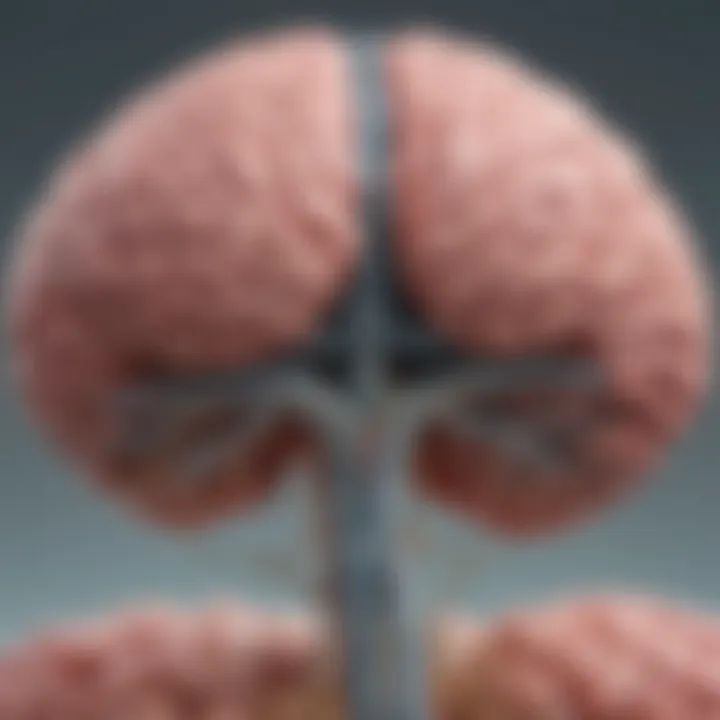
Intro
The investigation of brain stem masses stands as a crucial endeavor within neurology and oncology. The brain stem, nestled between the brain and the spinal cord, plays a vital role in many bodily functions, making any abnormal growth in this area particularly significant. Such masses can arise from various origins, including tumors, vascular anomalies, and inflammatory conditions. Given the brain stem's essential functions, the implications of these masses can be profound, affecting both neurological health and quality of life.
Understanding the nature of brain stem masses begins with a clear grasp of the neuroanatomy involved. The brain stem consists of three main components: the midbrain, the pons, and the medulla oblongata. Each of these regions has distinct functions and potential pathologies. Diagnostic methods are complex, often requiring advanced imaging techniques to differentiate the types of masses encountered.
This article aims to address the multifaceted aspects associated with brain stem masses, combining insights into their diagnosis, treatment options, and broader clinical implications. By engaging with current research and clinical practices, the intention is to provide a comprehensive resource for healthcare professionals, researchers, and students alike in the health field.
Key Findings
- Brain stem masses can originate from a variety of causes including primary tumors, metastases, and benign lesions.
- Early diagnosis is crucial due to the potential for neurological deterioration.
- Multidisciplinary treatment approaches, involving neurosurgeons, oncologists, and radiologists, are most effective.
Major Results
Recent research indicates several critical factors in the evaluation of brain stem masses. Imaging studies such as MRI play a key role in identifying the characteristics of these lesions. Additionally, the histological examination following biopsy can further clarify the mass's nature, allowing for targeted therapy based on specific tumor types. The prognosis associated with various brain stem masses can vary significantly, underscoring the importance of personalized treatment plans.
Discussion of Findings
The complexities surrounding brain stem masses cannot be overstated. Surgical options, while sometimes necessary, can be fraught with challenges due to the location of these masses. It is essential for professionals to consider the potential risks versus benefits of intervention. Moreover, advances in radiotherapy and chemotherapy have expanded the treatment landscape. Understanding potential outcomes associated with different treatment pathways is critical to informing patient care.
Methodology
An analysis of brain stem masses requires a structured approach.
Research Design
This article draws upon a comprehensive review of existing literature, encompassing peer-reviewed studies on brain stem masses. Specific attention is given to longitudinal studies that track treatment outcomes over time.
Data Collection Methods
Data for this article was collected through:
- Literature searches on databases such as PubMed and Google Scholar.
- Interviews with medical professionals specializing in neuro-oncology.
- Review of case studies highlighting various treatment approaches and patient experiences.
An intricate understanding of the diagnosis, treatment, and implications of brain stem masses is essential for advancing patient care. As we move forward in the article, detailed discussions will unfold on various diagnostic methods, treatment options, and the thorough implications of each decision made in this critical field.
Prelude to Brain Stem Mass
The study of brain stem masses is crucial for understanding neurological health and disease. This region of the brain is vital for many autonomic functions and is a central hub for neural pathways. A mass in the brain stem can lead to severe consequences due to its critical role in regulating vital bodily functions. Therefore, investigating brain stem masses allows healthcare professionals to diagnose and treat conditions that can significantly affect a patient's quality of life.
Definition and Importance
Brain stem masses refer to abnormal growths located in the brain stem, which comprises the midbrain, pons, and medulla oblongata. These masses can be tumors, cysts, or other pathological formations. Recognizing the type and implications of these masses is essential because they can cause a range of symptoms, affecting motor skills, sensation, and even vital functions like respiration and heart rate. Understanding their nature aids in forming a treatment plan that can include surgery, radiation, and other interventions.
The significance of diagnosing brain stem masses lies not only in the treatment but also in the broader implications for patient care. Early identification can lead to better patient outcomes and provide critical information for health professionals navigating complex neurological conditions.
Anatomical Overview
The brain stem is situated at the base of the brain, serving as a conduit for signals between the brain and the spinal cord. It plays an essential role in maintaining basic life functions. The midbrain is involved in vision and hearing, while the pons serves as a communication bridge between different parts of the brain. The medulla oblongata controls many autonomic functions like heart rate and blood pressure.
Given its role, any mass that develops in this area has the potential to disrupt these vital processes. Precise anatomical knowledge is crucial for clinicians to accurately assess the potential impacts of a brain stem mass. This understanding inform treatment decisions and the expected course of the illness.
Types of Brain Stem Masses
Understanding the various types of brain stem masses is crucial for accurate diagnosis and effective treatment of these conditions. This section will elaborate on the different categories of masses that can develop in the brain stem, their characteristics, and implications for patient management. Recognizing the type of mass helps in formulating a tailored treatment plan and in predicting patient outcomes. Each type possesses unique features, risks, and benefits associated with treatment options.
Tumors
Tumors in the brain stem can be classified primarily as either primary or secondary. Primary tumors originate in the region itself, whereas secondary tumors arise from distant sites and metastasize to the brain stem. The most common primary tumors include gliomas, which are often infiltrative and can result in significant neurological impairment.
Common types of brain stem tumors include:
- Astrocytomas: Frequently seen in children and can vary in aggressiveness.
- Ependymomas: Tumors that arise from the ependymal cells lining the ventricles and spinal cord.
- Brainstem gliomas: Generally more aggressive and often found in pediatric patients, these tumors can lead to various neurological deficits.
Treatment strategies may involve both surgical intervention and radiation therapy. The decision often weighs heavily on the tumor's specific type and location, emphasizing the need for a comprehensive evaluation by specialists.
Metastatic Lesions
Metastatic lesions in the brain stem originate from cancers elsewhere in the body. Common primary sources include lung, breast, and melanoma cancers. These lesions can significantly complicate the clinical picture due to their potential to cause widespread neurological symptoms.
Management of metastatic lesions often incorporates:
- Stereotactic radiosurgery: Focused radiation treatment directed at the lesion.
- Whole brain radiation therapy: Applicable when there are multiple lesions present.
- Systemic therapy: This may include chemotherapy or targeted agents, depending on the primary cancer type.
Early identification of metastatic brain stem lesions is vital. It can markedly improve patient quality of life and survival rates, underscoring the importance of vigilant monitoring for patients with known malignancies.
Benign Growths
Benign growths in the brain stem may include oligodendrogliomas or other non-cancerous masses like meningiomas. Though deemed non-malignant, they can still lead to considerable symptoms due to mass effect and pressure on adjacent neural structures.
The management of benign masses often involves:
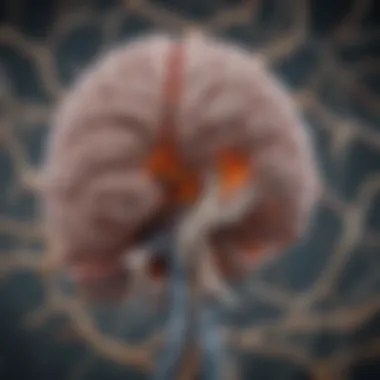
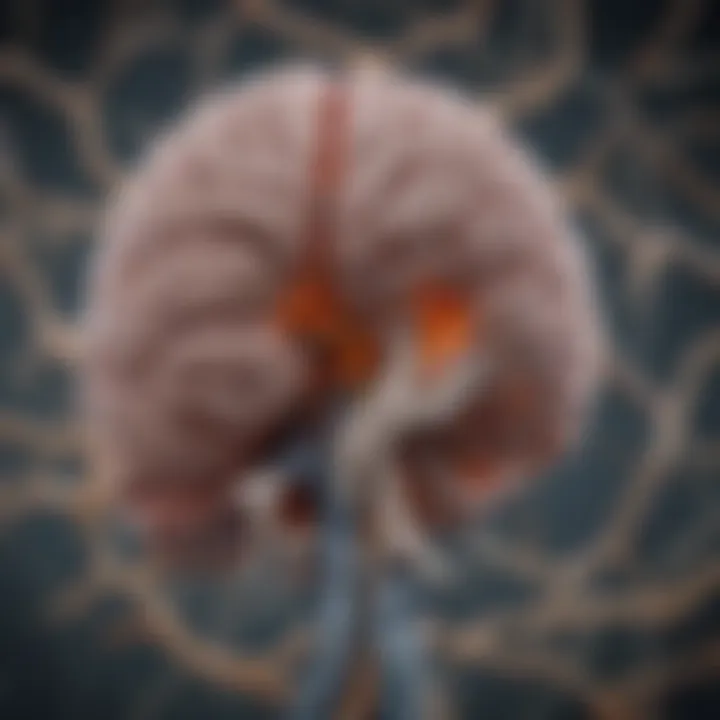
- Observation: If the mass is not causing symptoms, a wait-and-see approach may be adopted.
- Surgical resection: If the mass leads to significant symptoms, it may require removal.
Despite being benign, these masses can be deceptive in their impact on the patient's health, illustrating the need for thorough assessment and follow-up care.
Infectious and Inflammatory Masses
Infectious processes such as abscesses or inflammatory conditions can also present as brain stem masses. Examples include tuberculomas or neurosyphilis. These masses often require prompt identification to prevent complications.
Management typically includes:
- Antibiotics or antivirals: Targeting the underlying infectious etiology.
- Surgical drainage: May be necessary for large abscesses or when there is significant mass effect.
These types of masses often respond well to medical therapy, making their identification crucial to safeguarding patient health.
Early diagnosis and understanding the type of brain stem mass greatly influence management decisions and can affect patient outcomes considerably.
Etiology of Brain Stem Masses
Understanding the etiology of brain stem masses is vital for both diagnosis and treatment. The causes can be multifaceted and range from genetic predispositions to environmental factors and trauma. Identifying these elements is crucial as it influences clinical decisions and potential outcomes for patients. Examining the etiology can provide insights into how these masses develop, their implications for patient care, and the strategies necessary for effective management.
Genetic Factors
Genetic factors play a significant role in the development of brain stem masses. Certain genetic mutations can predispose individuals to tumors or other pathological growths in the brain stem area. For instance, conditions like Neurofibromatosis type 1 and 2, as well as Li-Fraumeni syndrome, are linked to an increased risk of neurological tumors. The presence of these syndromes can alert healthcare providers to a higher likelihood of brain stem masses in affected individuals.
Furthermore, familial clustering of these tumors may suggest an inherited component. Molecular genetics research continues to explore tumorigenesis mechanisms, exposing pathways which might be targeted for innovative therapies. Understanding these genetic links provides not just a basis for diagnosis but also aids in tailoring treatment plans that consider a patient’s genetic background.
Environmental Contributions
Environmental contributions to the etiology of brain stem masses include exposure to certain toxins, radiation, and infectious agents. For example, prolonged exposure to pesticides has been studied for its potential role in neurological disorders and malignancies. Additionally, ionizing radiation is a known risk factor, especially among individuals who have undergone treatment for other cancers.
Infectious diseases, such as neurotoxic conditions resulting from viruses or bacteria, can also contribute to abnormal growths. These environmental factors necessitate careful history-taking during diagnosis to consider lifestyle and occupational exposures. Recognizing these links not only informs preventive strategies but can also guide discussions regarding potential risks with patients.
Potential Traumatic Events
Traumatic events may also precipitate brain stem masses, although the correlation is less direct compared to genetic and environmental factors. Concussions, traumatic brain injuries, and other forms of trauma can lead to inflammation and, in some cases, neurogenesis that may give rise to atypical growths.
"Understanding the role of trauma in the development of brain lesions is important for preventative measures and treatment protocols."
Therefore, it is essential to evaluate patients with a history of significant brain injury for the potential of developing masses. This recognition can lead to prompt imaging and intervention to address any arising issues.
In summary, the etiology of brain stem masses is complex, involving a combination of genetic factors, environmental exposures, and traumatic events. A thorough understanding of these causes is critical for the effective diagnosis and management of patients.
Clinical Presentation
The clinical presentation of brain stem masses is a critical aspect of this article as it encompasses the signs and symptoms that influence diagnosis and treatment strategies. Understanding how these conditions manifest is essential for clinicians, as timely recognition can significantly affect patient outcomes. Furthermore, acknowledging the diversity of presentations helps in shaping a more nuanced approach to management.
Common Symptoms
Common symptoms of brain stem masses can vary widely, influenced by the location and size of the mass, as well as its nature. Patients may experience headaches, balance disturbances, and visual acuity changes. Such symptoms often indicate increased intracranial pressure or direct compression on cranial nerves.
Some frequently reported symptoms include:
- Headaches: These can be severe and persistent, often resembling migraines or tension-type headaches.
- Dizziness: This may occur due to disrupted coordination pathways, leading to unsteadiness.
- Visual disturbances: Patients might report blurriness or double vision, caused by cranial nerve involvement.
- Difficulty swallowing: Dysphagia can arise from impaired motor function in the brain stem.
- Altered consciousness: This is a significant concern and may point to advanced disease progression.
It is important for healthcare providers to assess these symptoms comprehensively. Not only do they guide the clinician in identifying cases that warrant further investigation, but they also serve as a basis for monitoring disease progression over time.
Neurological Deficits
Neurological deficits provide deeper insight into the functional impacts of brain stem masses. These deficits may involve motor, sensory, and autonomic systems due to the central role the brain stem plays in integrating these functions. Recognizing these deficits early can improve prognosis through prompt and appropriate management.
Common neurological deficits observed may include:
- Motor weakness: Often affecting one side of the body, depending on the mass's location.
- Sensory loss: This might manifest as decreased sensation or altered pain perception.
- Cognitive changes: Patients may experience confusion, memory issues, or other cognitive declines due to diffuse involvement.
- Autonomic dysfunction: Problems such as abnormal heart rate, blood pressure instability, or temperature regulation can be indicative of a deeper neurologic disruption.
It is crucial to recognize that neurological deficits might not be permanent. Some patients may recover functionality with appropriate treatment.
Accurate documentation of these clinical presentations is vital. It allows for constructing a tailored therapeutic plan and ensures that multidisciplinary teams can address all medical challenges effectively.
Diagnostic Techniques
In the realm of diagnosing brain stem masses, diagnostic techniques play a crucial role in making precise assessments. Accurate identification of the type of mass is vital for determining the most effective treatment plan. Various modalities and methods each have unique advantages and limitations that contribute to overall patient care. Understanding these tools helps healthcare professionals navigate complex clinical scenarios effectively.
Imaging Modalities
Magnetic Resonance Imaging
Magnetic Resonance Imaging (MRI) is often the first line of investigation for brain stem masses. Its ability to provide high-resolution images of soft tissues offers a distinct advantage over other imaging techniques. MRI is adept at differentiating between various types of tumors and can help in understanding their relationship with surrounding structures.
One key characteristic of MRI is its non-invasive nature, making it a popular choice for both initial evaluations and follow-up assessments. Furthermore, MRI is effective at revealing edema and other subtle changes in brain tissue. This unique feature allows clinicians to evaluate tumor margins and plan surgical approaches with greater precision.
However, the primary disadvantage of MRI is its longer duration compared to methods like computed tomography. Patients may need to stay still for extended periods, which can be challenging, particularly for those uncomfortable in enclosed spaces.


Computed Tomography
Computed Tomography (CT) is another critical imaging modality in the diagnosis of brain stem masses. CT scans are valuable because they provide rapid imaging and are widely available. The speed of CT is particularly advantageous in acute settings where timely diagnosis is essential.
One of the key characteristics of CT is its efficiency in revealing calcifications and bone involvement, which can be critical in certain types of tumors. Additionally, CT can provide quick information in emergency cases, helping guide immediate management decisions.
On the downside, CT’s reliance on ionizing radiation poses risks, especially in patients requiring multiple scans. Moreover, while CT is excellent for bony structures, it is somewhat limited in revealing fine details of soft tissue when compared to MRI.
Positron Emission Tomography
Positron Emission Tomography (PET) offers another layer of assessment in evaluating brain stem masses. Particularly useful in identifying metabolic activity, PET can help distinguish between benign and malignant conditions by detecting areas of increased glucose metabolism.
A significant advantage of PET is its ability to provide functional imaging data, offering insights into how well the brain is functioning around the mass. This characteristic can be crucial for treatment planning, especially in determining the extent of involvement and assessing response to therapies.
However, PET does have drawbacks. Its lower spatial resolution compared to MRI makes it less effective for detailing anatomical structures. Furthermore, the availability of PET scans can sometimes be limited, impacting timely diagnosis.
Biopsy Approaches
The next step in confirming the diagnosis often involves biopsy approaches. Biopsies are essential for obtaining tissue samples to determine the histopathological characteristics of the mass. These approaches can be performed through several methods, including stereotactic techniques or open surgery, depending on the location and type of mass.
Each of these diagnostic techniques should be applied judiciously, with a comprehensive understanding of their benefits and limits. Clinicians must weigh factors to ensure they utilize the most appropriate methods tailored to each patient’s specific situation.
Management Strategies
The management of brain stem masses is a critical topic, given the complexity of these conditions and their profound impact on neurologic function. Effective management strategies include surgical interventions, radiation therapy, and chemotherapy regimens. Each of these options comes with its own set of advantages and challenges. It is crucial to select appropriate strategies that best align with the type, size, and biological behavior of the mass, as well as the overall health and preferences of the patient.
Understanding these strategies not only improves patient outcomes but also shapes clinical practice and future research directions.
Surgical Interventions
Surgical intervention is often the primary treatment approach for brain stem masses. The rationale for surgery includes definitive diagnosis through biopsy, as well as the potential for complete or partial resection of the mass. The surgical approach must be meticulously planned, considering the intricate anatomy of the brain stem and the associated risks of neurological deficits.
- Benefits of Surgery:
- Potential for tumor removal, leading to symptom relief.
- Immediate sampling for pathology, facilitating accurate diagnosis.
- Possibility of improving survival rates, especially in specific tumor types like low-grade gliomas.
However, the risks associated with surgery are significant. These can range from infection and blood clots to more severe complications like motor or speech deficits. Thus, careful preoperative evaluation and imaging studies, such as MRI, are essential for selecting surgical candidates.
Radiation Therapy
Radiation therapy is frequently employed as an adjunct or alternative to surgery for brain stem masses. It is particularly valuable in cases where surgical resection is not feasible due to the tumor’s location or patient's health.
- Overview of Radiation Therapy:
- Utilizes high doses of radiation to target cancer cells.
- Can be used postoperatively to eliminate residual tumor cells.
Radiation therapy is generally effective in managing brain stem tumors, but it carries complications such as fatigue, skin irritation, and potential long-term effects on cognitive functions. The technology has evolved with methods like stereotactic radiosurgery, which delivers targeted radiation, minimizing exposure to surrounding healthy tissue.
Chemotherapy Regimens
Chemotherapy can also play a vital role, particularly in cases of malignant brain stem tumors or when dealing with metastasis. The choice of chemotherapy regimen typically depends on the specific tumor type and its molecular characteristics.
- Common Chemotherapy Regimens:
- Temozolomide for gliomas.
- Vincristine combined with carboplatin for specific pediatric tumors.
The effectiveness of these regimens varies, and their use may be limited by concerns about side effects and overall resilience of the patient. Side effects can include nausea, decreased blood cell counts, and increased risk of infection.
In summary, the management strategies for brain stem masses necessitate a comprehensive approach that takes into account the unique features of each case. It is essential for healthcare providers to collaborate and communicate with each other and with patients to develop tailored treatment plans.
Prognosis and Outcomes
Prognosis and outcomes for patients with brain stem masses are critical topics in understanding the implications of these medical conditions. Evaluating the prognosis can guide treatment strategies, help manage patient expectations, and inform families about potential outcomes. Notably, this area encompasses survival rates and quality of life considerations, both of which play significant roles in holistic patient management.
Survival Rates
Survival rates for individuals diagnosed with brain stem masses vary significantly based on several factors. Tumor type, patient age, and the overall health of the individual heavily influence these rates. For instance, patients with pilocytic astrocytomas, commonly found in younger populations, often have better outcomes compared to those with glioblastoma multiforme, which is highly aggressive.
Survival statistics show that:
- Pilocytic astrocytomas tend to have an approximate five-year survival rate of around 90%.
- Glioblastomas have a five-year survival rate that drops to about 5% to 10%.
- Metastatic tumors also tend to have lower survival rates, often correlating with the aggressiveness of the primary cancer.
Statistical data alone does not fully encapsulate the experience of each patient. Personal circumstances, including comorbidities and response to treatment, significantly impact prognosis. Early detection and intervention can improve outcomes, underscoring the importance of regular neurological examinations, especially in high-risk individuals.
Quality of Life Considerations
Quality of life (QOL) is a key consideration following the diagnosis of a brain stem mass. Treatments such as surgery, radiation, and chemotherapy can lead to a range of physical and emotional changes. Understanding these potential changes is paramount for care teams and patients alike.
Several aspects of QOL are essential:
- Neurological Function: Brain stem lesions often affect vital functions such as speech, motor skills, and autonomic functions. Disruptions in these areas can lead to significant lifestyle changes.
- Pain Management: Effective pain relief strategies are crucial, as pain can diminish the quality of life in patients.
- Emotional Well-Being: Psychological support is necessary to address depression, anxiety, and fear of recurrence. Support groups or therapy can be beneficial.
- Rehabilitation: Physical, occupational, and speech therapy can markedly improve QOL for those recovering from surgery or dealing with deficits.
Quality of life remains a pivotal aspect of the treatment process, influencing treatment choices and the overall approach to patient care.
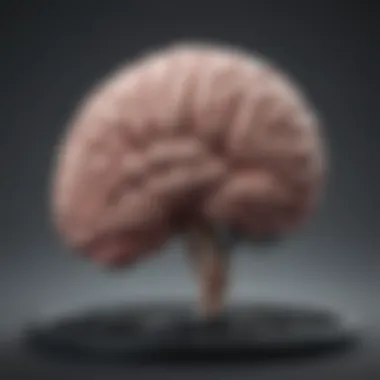
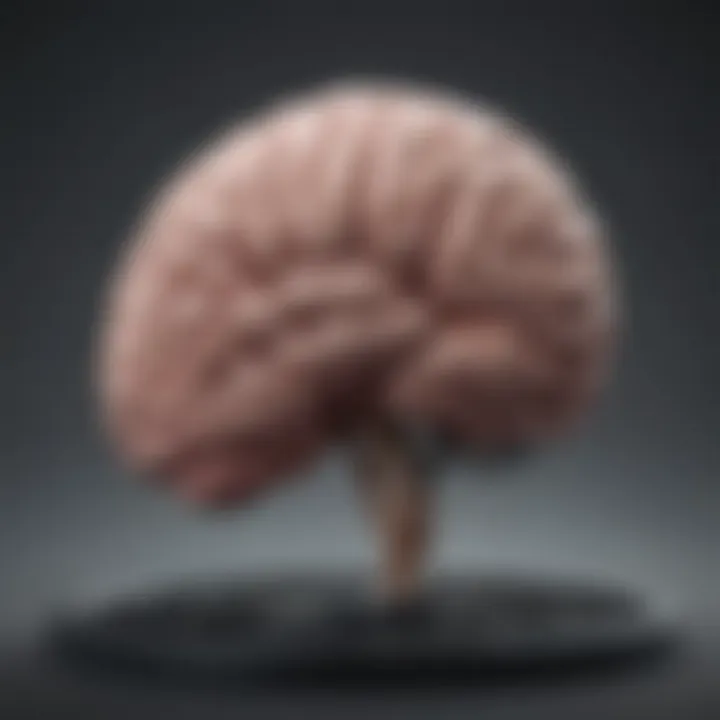
The intersection of prognosis and quality of life indicates a comprehensive view of managing brain stem masses. Healthcare professionals must work collaboratively to optimize both the medical and holistic aspects of patient care.
Multidisciplinary Approach
In managing brain stem masses, a multidisciplinary approach is essential. This method integrates various healthcare professionals, each contributing their expertise to optimize patient outcomes. The complexity of brain stem conditions necessitates collaboration among specialists to address the diverse aspects of diagnosis, treatment, and ongoing care.
With a brain stem mass, patients often display a range of neurological symptoms, which can vary widely depending on the mass's location and type. These symptoms demand precise evaluation and tailored treatment strategies. Therefore, having a team of specialists allows for comprehensive care, ensuring that no aspect of the patient’s condition is overlooked.
This approach offers several advantages:
- Comprehensive Evaluation: Different specialists provide unique insights during the diagnostic phase, improving accuracy.
- Tailored Treatment: Combining treatments from various disciplines leads to personalized patient care, potentially enhancing effectiveness and minimizing adverse effects.
- Ongoing Support: A cohesive team can provide continuous support throughout the treatment process and into recovery, considering both physical and emotional needs.
In summary, a multidisciplinary approach to brain stem masses enhances the quality of care by leveraging the collective expertise of various medical professionals.
Role of Neurologists
Neurologists play a pivotal role in diagnosing and managing brain stem masses. They are the experts in the nervous system, equipped with the skills to interpret symptoms accurately and assess neurological deficits. Through history-taking and neurological examination, a neurologist can often pinpoint potential issues early in the diagnosis process.
They often rely on imaging results from MRI or CT scans to evaluate the size, shape, and type of mass. Their understanding of neuroanatomy helps in correlating imaging findings with clinical symptoms, guiding further therapeutic decisions. Neurologists also manage symptomatic treatment, such as medications for headaches or seizures, which can occur due to brain stem masses.
Furthermore, neurologists serve as coordinators among the multidisciplinary team, ensuring seamless communication between various specialties for patient care.
Input from Oncologists
Oncologists provide critical input when a brain stem mass is suspected to be malignant. Their expertise lies in cancer treatment and they guide the team in determining whether the mass is a primary brain tumor or a metastatic lesion stemming from another cancer site.
They assess the tumor subtype and molecular characteristics, which inform treatment decisions such as chemotherapy or targeted therapy. Oncologists are also crucial in discussions about the prognosis, helping to draw conclusions based on tumor behavior and response to treatment.
Additionally, they can provide valuable advice regarding clinical trials for new therapies, expanding options for patients who may not respond well to standard treatments. Overall, the oncologist's role ensures that the approach is aggressive yet balanced, focusing on maximizing patient quality of life while managing disease progression.
Collaboration with Neurosurgeons
Neurosurgeons are integral to the management of brain stem masses, particularly when surgical intervention is warranted. Their expertise is essential in assessing operability, considering factors such as the mass's location, size, and involvement with surrounding structures.
During surgery, neurosurgeons aim to excise the mass while preserving critical neural pathways, which is vital for maintaining the patient's neurological function. They also play a key role in real-time decision-making during surgery, often collaborated with intraoperative imaging techniques to enhance accuracy.
Post-surgery, neurosurgeons continue to monitor patients for any complications or required further treatment. Their collaboration with neurologists and oncologists ensures that the patient receives comprehensive post-operative care tailored to their needs.
Future Directions in Research
Research in the field of brain stem masses remains a critical area for advancement. As our understanding of the complexities surrounding these conditions grows, it is essential to explore avenues for future investigations. This section emphasizes the need for sustained research efforts to enhance diagnostic methods, refine treatment protocols, and ultimately improve patient outcomes.
There are several specific elements within future research that warrant attention, including the development of more accurate imaging techniques and innovative therapeutic strategies. Both of these areas not only hold the potential to change how we approach brain stem masses but also enhance the way clinicians manage and treat affected patients.
Moreover, the consideration of collaborative research across disciplines is crucial. Integrating insights from neurology, oncology, radiology, and surgery will yield comprehensive strategies to combat these serious conditions and facilitate quicker breakthroughs.
By fostering a robust dialogue between experts from various fields, we can establish a more holistic understanding and cater to patient needs effectively.
"The future of brain stem mass research lies in the interplay between advanced imaging and treatment modalities, providing new hope for patients and clinicians alike."
Innovative Imaging Techniques
The advent of novel imaging techniques can radically change the diagnostic landscape for brain stem masses. Traditional imaging methods, while valuable, often lack the resolution and sensitivity needed for early detection and accurate characterization. Future directions should focus on developing more sophisticated imaging technologies, such as high-field Magnetic Resonance Imaging (MRI) and advanced functional imaging techniques.
- High-Field MRI: These systems can provide unparalleled detail in visualizing brain structures. The precision offered assists in distinguishing between tumor types and planning treatments accordingly.
- Diffusion Tensor Imaging (DTI): This form of MRI measures the movement of water molecules in brain tissue. DTI may reveal information about the integrity of neural pathways affected by brain stem masses, guiding both diagnosis and treatment.
- Functional MRI (fMRI): fMRI measures brain activity by detecting changes associated with blood flow. This can be particularly useful in assessing how masses affect brain function and may help in surgical planning.
The integration of these advanced techniques into routine practice holds significant promise. Enhanced diagnostics help in formulating individualized treatment plans, optimizing patient management, and ultimately leading to better prognoses.
Advancements in Therapeutics
Therapeutics for brain stem masses must evolve in parallel with advancements in diagnostic techniques. Traditional treatment modalities, such as surgery, chemotherapy, and radiation therapy, continue to see improvements, but further innovation is critical to address the unique challenges posed by these masses.
Future therapeutic research might include:
- Targeted Therapies: Developing drugs that specifically target the molecular underpinnings of brain stem tumors could increase treatment efficacy and minimize collateral damage to surrounding healthy tissue.
- Immunotherapy: Harnessing the body’s immune system presents a promising vector for treatment. Approaches like CAR T-cell therapy are being explored for their potential to treat aggressive types of tumors.
- Personalized Medicine: Tailoring treatment plans based on the genetic and molecular profiling of individual tumors may improve outcomes for patients and reduce unnecessary side effects.
Thus, greater exploration into these therapeutic directions is essential. The ultimate goal is to transition from a generalized treatment approach to one that is more tailored and effective. Enhancing therapeutic options will advance patient care for brain stem masses, ensuring that each individual receives the most appropriate and efficacious intervention.
Culmination
The conclusion serves as the summary of key insights gained throughout the exploration of brain stem masses. It underscores the critical understanding of diagnosis, treatment, and implications surrounding these conditions. The significance of this section is multifaceted, as it distills the complexities of the topic into digestible takeaways. Emphasizing the importance of a cohesive narrative highlights the need for healthcare professionals to be aware of the evolving nature of treatment approaches.
Through this article, various studies and clinical practices have been synthesized. This integration provides clarity on procedures and strategies in managing brain stem masses. An effective conclusion not only encapsulates the findings but also signals the importance of continual engagement with advancements in research related to this field.
Summary of Findings
The findings indicate that a variety of mass types can occur within the brain stem, each with unique characteristics and implications. The thorough examination of diagnostic techniques reveals that imaging modalities such as Magnetic Resonance Imaging and Computed Tomography are indispensable in identifying and characterizing brain stem lesions. Furthermore, treatment regimens vary widely, encompassing surgical intervention, radiation therapy, and chemotherapy.
Key takeaways from the article include:
- Brain stem masses can be tumors, metastatic lesions, benign growths, as well as infectious and inflammatory sources.
- Diagnostic precision is critical for effective treatment; imaging modalities play a vital role in this process.
- A multidisciplinary approach enhances the management of patients suffering from these conditions, emphasizing the collaboration among neurologists, oncologists, and neurosurgeons.
Implications for Practice
Healthcare practices are impacted significantly by the insights gained from this article. First, the recognition of diverse brain stem mass types can influence early intervention strategies. Understanding variations in symptoms and their neurological implications empowers clinicians to refine diagnostic processes.
Moreover, the emphasis on multidisciplinary collaboration fosters a comprehensive strategy for addressing brain stem masses. This approach not only improves patient outcomes but also contributes to the overall quality of care delivered. Emphasizing continued education and adaptation to new therapeutic advancements will further align practices with current evidence-based medicine. As research progresses, professionals must remain vigilant to integrate new findings into ongoing patient care.



